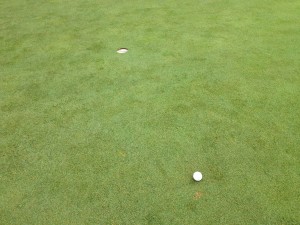Too many three putt holes during a round are one of the major roadblocks in the way of high handicap golfers shooting bogey golf. Even if we do everything else right on the hole and hit the green in regulation, we still only reach our goal of scoring a bogey if we three putt. We need to take advantage of hitting greens in regulation by making pars or better yet birdies. High handicap golfers are not going to hit most greens in regulation. Three putts on these holes will lead to double bogies or worse. Too many of these holes, no matter how well we play on the other holes, and we can never recover to shoot a round of bogey golf.
How do we minimize three putts?
Speed is the number one factor in reducing three putts.
The speed of the putt determines how far the ball will travel. Except for a few putts with extreme slope that will break a tremendous amount, you will always be within a few feet of the hole for your second putt if you have the correct speed regardless of whether or not you judge the break correctly. Obviously the key to reducing three putts is to leave yourself high percentage putts for your second putt if you don’t sink your first putt.
A consistent putting stroke is key for having the correct speed on your putts.
There are several different putting styles, grips and putters one can use. I do not believe any of these has a major advantage over the others. The putter you choose comes down to what feels most comfortable to you.
There are things you will want to do consistently regardless of the putter you use.
- Your eyes should be over the ball. The putting stroke and stance are much different than the full swing setup. Your head should be directly over the ball and you should be looking straight down at the ball. From this position, it is easiest to create the pendulum motion needed for a consistent putting stroke. Your shoulders act as the base of the pendulum if you are using a short putter. Your wrists remain still unlike in the full golf swing. The end of the putter acts as the base of the pendulum and is anchored to your body if you are using a long putter.
- When putting, your follow-through should be as long as the backswing. Many high handicap golfers do not follow all the way through on their putting stroke. This is important for all putts but especially for short ones. The length of your putting stroke should also relate to the length of the putt. The longer the putt, the longer your stroke should be.
- Try to putt the ball 12 to 18 inches past the hole on every putt within 15 feet. You’ll never make putts that do not reach the hole. The more putts you can make means less short ones to finish up and fewer strokes on your scorecard. Consistently leaving your putts 12 to 18 inches past the hole puts the ball at the ideal speed to go in when it does catch part of the hole.
Get a good read on the elevation change from your ball to the hole.
Most high handicap golfers I see only read the break of the putt from behind the ball looking toward the hole. I do what you see most professionals do. I read the putt from both behind the ball looking toward the hole and from behind the hole looking toward the ball. Sometimes the break is much easier to see from one side over the other. When walking to the other side, I pause and look at the putt from the side. This view provides the best look of any elevation change from the ball to the hole which is crucial in judging the correct speed of the putt. You may be thinking this will take too long but there is actually plenty of time on the green to do this while others are lining up chips and putts.
Judging the correct speed of your putts will get you close to the hole if not in but there is another thing needed to minimize three putts.
You can do a great job of judging speed, but you will inevitably misread the break on a lot of putts leaving two to three foot putts. You have to have the mindset that you are going to make all of these. The biggest help in making short putts is to practice them. I see people practice their putting on the practice green all the time but how many of them do you see practicing short putts or at least finishing up the putts they leave from their long attempts? Include some time on the practice green to practice three foot putts.
As we touched on earlier, remember to follow through on every putt – especially the short ones. I have a tendency of not following through on short putts. I end up “stabbing” at the ball and pushing the putt to the right.
Three putts can wreck an otherwise good round. You can shave a lot of strokes from your score on the green. The correct speed of putts and the ability to make almost every short putt will reduce the number of three putts you have.


